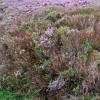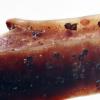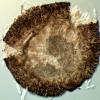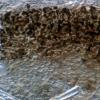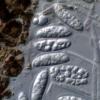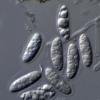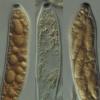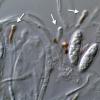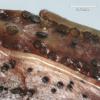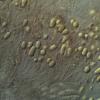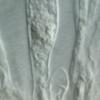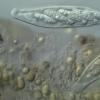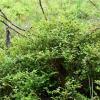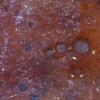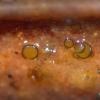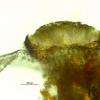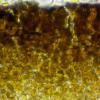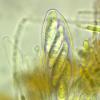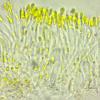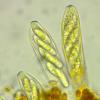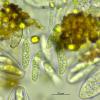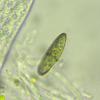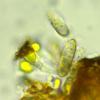
12-12-2025 18:39
Mirek GrycHello everyone.Macrofeatures similar to Mollisia b

09-12-2025 12:06
 Andgelo Mombert
Andgelo Mombert
Bonjour,Je recherche l'article concernant Hypobryo

07-12-2025 16:07
Arnold BüschlenHallo, ich habe in einer Moos-Aufsammlung (epiphy

08-12-2025 21:04
Mark Stevens"Hello everyone,I'm relatively new to microscopy (

08-12-2025 18:59
 Lothar Krieglsteiner
Lothar Krieglsteiner
.. found by a seminar-participant, I do not know t

08-12-2025 17:37
 Lothar Krieglsteiner
Lothar Krieglsteiner
20.6.25, on branch of Abies infected and thickened

16-03-2014 22:00
Hello,I found this species a few months ago but ha
Micropeziza on Vaccinium stem
Chris Yeates,
19-08-2020 20:40

Bonsoir tous
Collected yesterday on damp dead Vaccinium myrtillus stems in a relatively small area of Calluna / V. myrtillus / Molinia moorland.
Interestingly, this site is less than 5 kilometres away from the first collection of Micropeziza filicina (see Ascomycete.org, 5 (4) : pp.129-136) but it is clearly not that - a very different substrate and larger ascospores - 13.9-15.7 x 4.6-5.2µm. I know that other Micropeziza spp. have been recorded on Ericaceae, but those were (as far as I am aware) on Rhododendron leaves.
An interesting feature is that the freshly ejected ascospores have a sheath - clearly shown in the accompanying images. I'm fairly certain that this is a Micropeziza based on the encrusted excipulum, Calycina-type ascus apex (strongly blue in Baralsche Löhsung), and other features.
I wonder whether this might be undescribed? Any comments very welcome - I shall post more images in due course; as you can see the collection is in good condition.
Cordialement, Chris
Hans-Otto Baral,
19-08-2020 21:05

Re : Micropeziza on Vaccinium stem
Yes, could be undescribed. And it is in better shape than the two samples in my folder.
But not good enough: the paraphyses should contain yellow VBs when alive.
Chris Yeates,
19-08-2020 22:12

Re : Micropeziza on Vaccinium stem
Thanks for the swift response Zotto. Yes the paraphyses do have yellow contents particularly at the apices - I'll attempt to get better pictures tomorrow, there are quite a few apothecia and as you say the fungus is in good condition / stages of development.
I should have checked your images first - I think we are dealing with the same species. Where was your collection made?
Do you have any idea where this has come from: https://species.wikimedia.org/wiki/Pezizellaceae ? It's followed in Species Fungorum but not Mycobank . . .
VG
Chris
Hans-Otto Baral,
19-08-2020 22:22

Re : Micropeziza on Vaccinium stem
HB 9378: Lapland, Saxnäs, Bjurälven, leg. Björn Norden. On standing 1-2 mm thick dead stems (upper parts) of Vaccinium myrtillus, lower parts often still alive, soc. Coccomyces leptideus & setose pyrenomycete.
13.IX.2015: P. Thompson: gregariously on a dead stem of Vaccinium myrtillus (locality unknown to me).
Pezizellaceae: Looks like a copy from Syllabus but with some changes. Wrong is to put Bisporella there.
Chris Yeates,
25-08-2020 15:58

Re : Micropeziza on Vaccinium stem
As promised a few further images. Looking now at the previous images I can see that although the spores were alive, the paraphyses were not.
The piece of stem was kept damp in a fridge for several days and the ascomata developed somewhat. Here one can clearly see the yellow apical contents of the paraphyses, mentioned by Zotto. Also an ascus base, which I would say shows croziers? The asci show a clear space around the spores, which I think is a reflection of the spore "sheaths" shown in the original post.
I shall keep an eye out for this fungus as it appears to be widespread if overlooked (the apothecia, as can be seen are rather small. As ever comments welcome.
Cordialement, Chris
Hans-Otto Baral,
25-08-2020 17:04

Re : Micropeziza on Vaccinium stem
Yes, it is a crozier. Interesting species.
Elisabeth Stöckli,
18-07-2021 01:12
Re : Micropeziza on Vaccinium stem
Bonsoir,
Récolte réalisé sur bois de Vaccinium myrtillus (Tourbiére à 1'017 m), apothécies 0.1 - 0.4 mm de diamètre, sessile, hyménium jaune, surface externe brun foncé, asques octosporés, 58 - 82 x 13 - 16 µm, IKI+, avec crochets, spores hyalines, lisses, multiguttulées, 15 -20 x 4 -5 µm, paraphyses élargies au sommet avec vacuoles réfringentes. Je pense avoir trouvé la même espèce que Chris a présenté dans ce forum. Merci d'avance.
Elisabeth
Récolte réalisé sur bois de Vaccinium myrtillus (Tourbiére à 1'017 m), apothécies 0.1 - 0.4 mm de diamètre, sessile, hyménium jaune, surface externe brun foncé, asques octosporés, 58 - 82 x 13 - 16 µm, IKI+, avec crochets, spores hyalines, lisses, multiguttulées, 15 -20 x 4 -5 µm, paraphyses élargies au sommet avec vacuoles réfringentes. Je pense avoir trouvé la même espèce que Chris a présenté dans ce forum. Merci d'avance.
Elisabeth
Hans-Otto Baral,
18-07-2021 09:24

Re : Micropeziza on Vaccinium stem
Great, Elisabeth, I think all in my folder are the same species. Now you can start doing a description :-)
How could this species have been classified in the old literature, perhaps as a Pezicula? P. myrtillina? That has hemiamyloid apical rings, and Orbilia boydii is a synonym. Eupropolella vaccinii is erumpent and has brown 1-3-septate spores. And Pseudophacidium ledi has eguttulate spores and is also erumpent.
More I do not have in my literature database for Ericaceae and such a spore size.
Zotto
Chris Yeates,
18-07-2021 14:29

Re : Micropeziza on Vaccinium stem
Wonderful!
I'm sure it is the same species. On the lower right hand spore I think I can see a trace of the spore "sheath" I mentioned in the original post - I don't think that's an artefact.
It would be good to get this described, it would appear that only M. umbrinella has been sequenced. Using the key to Micropeziza in Ascomycete.org 6(5) p.123 this would key out as M. fenniae, clearly a different species (spore shape, size and guttulation, and very different micro-habitat).
Amitiés, Chris
Hans-Otto Baral,
18-07-2021 17:09

Re : Micropeziza on Vaccinium stem
Yes this looks like a sheath as in your pics.
Scleropezicula seems to be a related genus based on DNA.
Elisabeth Stöckli,
21-07-2021 11:08
Hans-Otto Baral,
21-07-2021 11:35

Re : Micropeziza on Vaccinium stem
Cher Elisabeth
Eupropolella does not have any VBs in the paraphyses, so I would exclude that. Also the brown exudate I do not remember there.
Is your collection from this month or another dateß
Zotto
Elisabeth Stöckli,
21-07-2021 11:54
Re : Micropeziza on Vaccinium stem
gefunden am 17.07.2021
Elisabeth
Elisabeth
